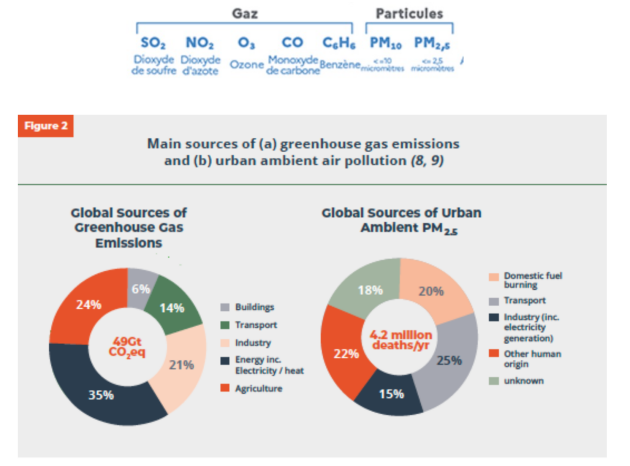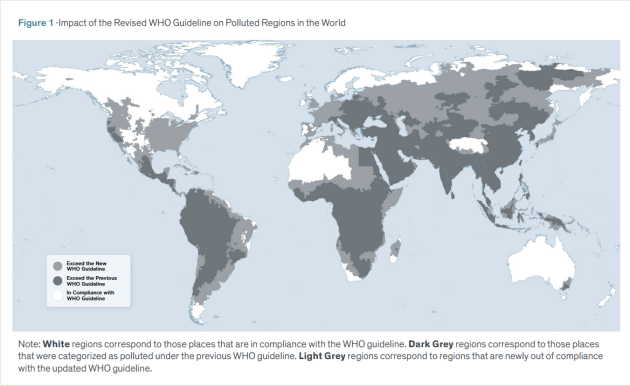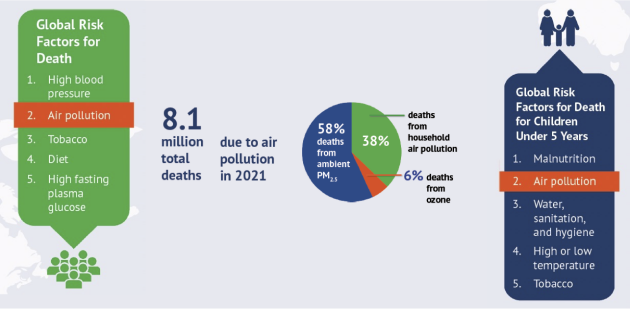Atmospheric pollution
Atmospheric pollution and climate change : common causes & close interractions
One of the most obvious links between climate change and poor health is air pollution. The use of fossil fuels for energy production, transport and industry is the main source of CO2 emissions responsible for climate change and a major contributor to air pollution that is harmful to health.
The sectors that produce the majority of greenhouse gases (energy, transport, industry, agriculture, waste management and land use) are also the main contributors to emissions of fine particles and other major air pollutants. Around 25% of urban air pollution linked to fine particles comes from road traffic, and 15% from industrial activities, including electricity generation. At the same time, the sectors that generate the GHG emissions responsible for climate change are: 14% for transport, 34.6% for the energy used to produce electricity and heat, and 21% for industry.
Some pollutants contribute to both climate change and local air pollution. Black carbon, produced by inefficient combustion in sources such as cooking stoves and diesel engines, is a major contributor to global warming. It is also responsible for a significant proportion of urban exposure to fine particles. Methane, another major contributor to global warming, reacts with other pollutants to form ozone. This gas is responsible for 230,000 deaths every year from chronic respiratory diseases.
With global warming, air quality will deteriorate further. Climate change disrupts the natural process by which atmospheric pollutants break down and disperse. Rising temperatures encourage chemical reactions that form tropospheric ozone from precursor pollutants such as nitrogen dioxide, emitted by vehicles, chimneys, incinerators and forest fires under the effect of solar radiation. If current emissions continue, pollution linked to tropospheric ozone (at ground level) is likely to intensify, particularly in densely populated urban areas, leading to an increase in respiratory illnesses. Furthermore, in certain regions, the frequency and scale of forest fires, and therefore emissions of fine particles and other pollutants, are also expected to increase.
Air pollution : global endemic exposure
Armed with a wealth of scientific evidence on the negative health effects of exposure to fine particle pollution, even at relatively low concentrations, on 22 September 2021 the World Health Organization (WHO) updated its guidelines on the acceptable level of air pollution that people can breathe. This revision lowered the concentration limit for fine particles (PM2.5) from 10 μg/m³ to 5 μg/m³, the first update since the guidelines were established in 2005.
The revised data, including satellite data, shows that, based on air pollution levels in 2020, 80.2% of the world's population lived in areas where PM2.5 concentrations exceeded the previous WHO limit of 10 μg/m³. However, with the new, stricter limit of 5 μg/m³, 97.3% of the world's population now lives in areas where air pollution exceeds this recommended threshold.
This means that a very large majority of the world's population is exposed to levels of air pollution that are now considered too high to ensure good health, according to new WHO standards. Fine particles, or PM2.5, are micro-particles of air pollution that can penetrate deep into the lungs and reach the bloodstream, contributing to a range of health problems, including respiratory and cardiovascular disease, as well as negative effects on mental health.
Air pollution : a major cause of morbidity and mortality
Air pollution, both indoors and outdoors, is the second leading risk factor for death in the world, both in the general population and in children under the age of 5. By 2021, it is estimated that more than 8 million people will die as a result of air pollution. Air pollution is responsible for 30% of deaths from lower respiratory tract infections, 28% of deaths from ischaemic heart disease and 48% of deaths from chronic obstructive pulmonary disease (COPD). It is also a major risk factor for lung cancer. Countries in South Asia and Africa are the worst affected by this public health problem.
The negative effects of air pollution on health can occur even at very low levels of exposure, whether acute or chronic. For example, the relationship between exposure to fine particles (PM2.5) and mortality follows a non-linear exposure-response curve, with a rapid increase in the risk of death at low levels of exposure, followed by a certain levelling off at higher levels of exposure. In other words, even modest exposure to air pollutants can have serious consequences for health, especially in terms of cardiovascular disease. The relationship between air pollution and cardiovascular disease is now well documented, and shows that there is an increased risk even at levels of exposure deemed ‘acceptable’ in certain national standards, such as those in the United States for fine particles and ozone.
Air pollution is a systemic problem that can only be solved by strong public policies and an even greater commitment to change. The Air Quality Life Index demonstrates the importance of such policies by showing that cleaner air translates into additional years of life for people around the world. According to the latest data, sustainably reducing air pollution worldwide to meet World Health Organisation guidelines would add 2.2 years to average life expectancy.


